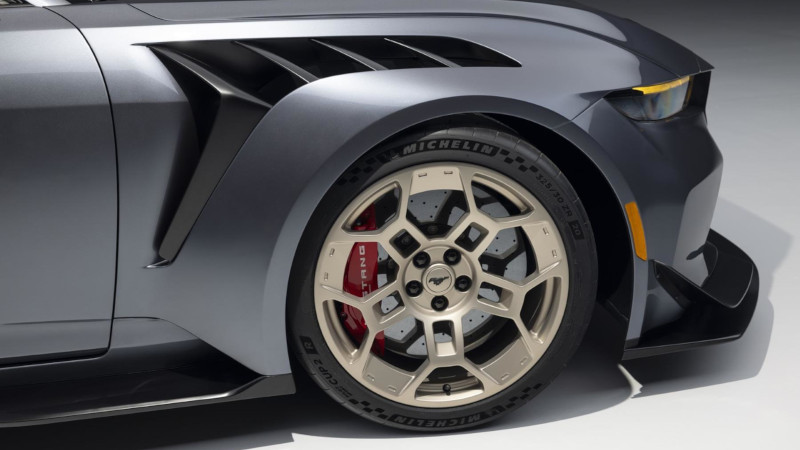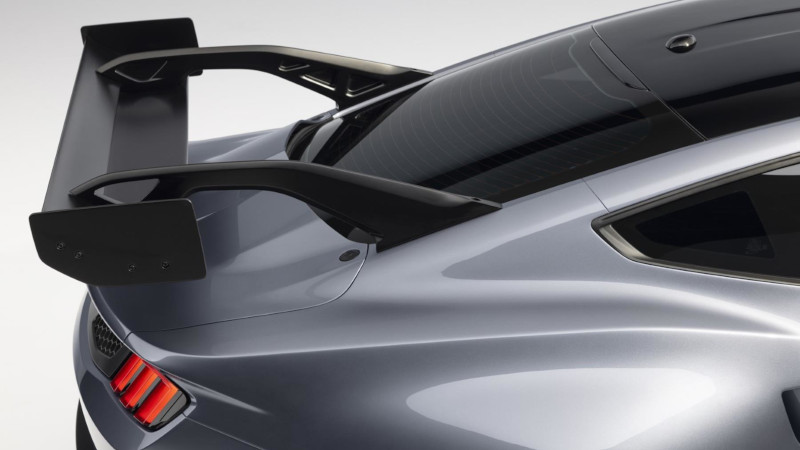Mustang GTD is the most audacious and advanced Mustang ever, a limited-edition, street legal, 600 kW performance car designed to take on the world’s best.
Deep inside a metal storage garage hidden behind a wind tunnel building in Allen Park, Michigan, a handful of team members gathered in 2021 for a new, after-hours mission: design a Mustang to take on the best of European sports cars.
The result is a limited-edition, ultra high-performance street legal performance car, according to Ford.
“Debuting today is the all-new 2025 Ford Mustang GTD, a technological tour de force inspired by the Mustang GT3 and slated to race in Le Mans next year. Unapologetic in its heritage, unbelievable in its performance, its sculpted mostly carbon fibre wide body and looming rear wing says everything in just a glance. This is like no Mustang ever,” Ford enthused.

Great expectations
“Mustang GTD shatters every preconceived notion of a supercar,” said Jim Farley, Ford president and CEO. “This is a new approach for us. We didn’t engineer a road car for the track, we created a race car for the road. Mustang GTD takes racing technology from our Mustang GT3 race car, wraps it in a carbon fibre Mustang body and unleashes it for the street.”
According to Ford, every precision part of Mustang GTD is purposefully designed. Every form is driven by function. It is designed to do one thing: Go faster around a track with more technology than the race cars it’s based on. The Mustang GTD was developed by many of the same people behind Ford’s Mustang race cars and the Le Mans-winning GT. It’s built to be the quickest roadgoing Mustang ever.
The company explained that the Mustang GTD is planted to the tarmac by downforce from available active aerodynamics and enormous grip from huge tires mounted to an advanced dual ride height short-long arm front and multi-link rear suspension. “It stops with authority thanks to carbon ceramic brakes, includes a rear-mounted 8-speed dual-clutch transaxle and lightweight carbon fibre driveshaft for near 50/50 weight distribution. Everything is driven by a supercharged 5,2-litre V8 targeting and estimated 800 hp (597 kW).”
Keeping the Le Mans legacy going
Ford explained that the Mustang GTD was born from the concept of the Mustang GT3 race car returning to Le Mans next year and will be the pinnacle of the Mustang family that now includes both street-legal and track-only race cars. This family includes the recently revealed Mustang GT4, the Mustang GT3, as well as the upcoming Mustang Dark Horse R spec racer and more. The GTD name for this newest Mustang refers to the IMSA “GTD” racing class for cars that are built to FIA GT3 technical regulations.
“I’ll take track time in a Mustang GTD against any other auto boss in their best road car,” said Farley.
Designed and engineered as a collaboration between Ford and Multimatic, which developed the Mustang GT3, Mustang GT4, and Le Mans-winning Ford GT, the Mustang GTD “represents the culmination of decades of engineering advancement borne from continuous learning through racing. Crafted with intent and precision, it’s destined to become an iconic part of Mustang and Ford history,” Ford stated.

Chiseled to exploit the air
The Mustang GTD design is pure purpose. Every line drives aerodynamic performance at track speed, from the front splitter, vented hood and fenders to the available C-pillar mounted hydraulically controlled active rear wing, Ford revealed.
“Mustang GTD takes advantage of the extensive use of carbon fibre body panels to reduce weight, lower centre of gravity and improve responsiveness. The fenders, hood, cover that replaces the trunk lid, door sills, front splitter, rear diffuser and roof are all carbon fibre with optional carbon fibre front and rear facias,” Ford stated.
[mailchimp_list]
Active aero
An available aero package that includes a comprehensive underbody aerodynamic tray is also executed in carbon fibre and includes features pioneered in motorsports racing, as well as some technology that would be illegal in racing, such as hydraulically controlled front flaps to manage airflow for aerodynamic balance in coordination with the active rear wing.
Where there once was a trunk is now the semi-active suspension, a hydraulic control system, and a transaxle cooling system that uses a race-inspired cover that replaces the trunk lid and includes two air scoops to funnel air off the back glass into the area and through the heat exchangers.
“Our design team worked in conjunction with the Mustang GT3 design team and the aero team, sharing solutions between race car and road car, and vice versa,” said Anthony Colard, Ford Performance design manager, “This is an aerodynamics-driven design.”
The combination of purposefully designed aerodynamic features will result in massive downforce balanced across both front and rear axles and will in turn drive corner speeds up, produce consistent control.
Extreme performance and technology
“The hardware has been carefully selected and developed to enable blistering lap time performance,” said Greg Goodall, Ford chief program engineer, “The target for this project was clear – go much, much faster than we’ve ever gone before with a targeted sub-7-minute Nürburgring time.”
Ford says the Mustang GTD employs a purpose-developed supercharged 5,2-litre V8 with dual air inlets and the first dry-sump engine oil system fitted to a roadgoing Mustang to help keep the engine lubricated during sustained and demanding cornering. The engine’s more than 7 500 rpm redline generates exceptional notes through the available titanium active valve exhaust system. It’s the highest horsepower street-legal Mustang ever developed by Ford, a source at the company said.
Power is sent from the engine to the rear wheels through a carbon-fibre driveshaft connected to an 8-speed rear transaxle for near 50/50 weight distribution between the front and rear.

Suspension, wheels and brakes
The Mustang GTD’s performance is further enhanced by semi-active suspension that can vary both spring rates and ride height. The adaptive spool valve damper technology with hydraulically actuated dual spring rate and height suspension provides two unique states which enhance on-road and on-track performance independently. The suspension settings allow for nearly 40 mm lower ride height in Track Mode and overall has a nearly 100 mm wider track than the Mustang GT.
Road grip and cornering stability for the Mustang GTD come from 325 mm width front tires – as wide as the rear tires of Ford GT – while the rear is 345 mm. These are mounted on 20-inch forged aluminium wheels or available forged magnesium wheels. The magnesium wheels offer the ideal combination of weight and durability and with a similar design to the Mustang GT3 race car.
Behind those wheels are massive Brembo carbon ceramic brakes, which are optimised for heat rejection leading to harder, more consistent stopping further into the braking zone. Rear brake heat is shed with the aid of cooling ducts mounted below the rear suspension.
The Mustang GTD features technology new to Ford with Variable Traction Control in track mode. This allows the driver to push the limits of the car by modulating engine output and traction control intrusiveness. Adjustments can be made without taking hands off the wheel, allowing drivers to match track conditions to their driving ability.

Cabin space
The cockpit features are finished in premium materials including Miko suede paired with leather and carbon fibre, while digital displays keep drivers engaged and in full command. Recaro seats optimized for track days are complemented by available 3D-printed titanium paddle shifters, rotary dial shifter and serial plate, all made from retired Lockheed Martin F-22 fighter jet titanium parts. The rear seating area has been removed to reduce weight and provide cargo space, Ford disclosed.
Colour options
Mustang GTD will be available with multiple interior colour combinations and in several special option packages. The car can also be ordered in any colour, even colour-matched to a customer-provided sample. These customisable options allow buyers to personalise their example should they choose to make it entirely unique. The end result is an unmistakable presence, as close to a race-ready Mustang GT3 for the street as possible, Ford stated.
Production of Mustang GTD will be limited, and pricing is expected to begin at approximately $300 000. If you can have one imported to South Africa, expect to pay more than R6 million.
Each GTD will start life at the Ford Flat Rock Assembly Plant and then be transported to Multimatic facilities in Markham, Canada, where it will be handcrafted for racing-inspired precision by the Ford Performance and Multimatic teams. The Mustang GTD will be available in late 2024, early 2025.






























